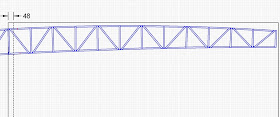As part of my attempt to learn how to use a 3D CAD program, I have been using my
Three Brothers powerboat design as an exercise. Although the design is still under development, I thought that some people may be interested in seeing a stage-by-stage stitch-and-glue assembly sequence.
This assembly sequence is only one of several approaches to stitch-and-glue construction, but most have a common theme of not requiring a strongback or mould set-up. The shape of the boat is determined by the accurate design, marking-out, and cutting-out of the primary parts - if everything is done correctly, the boat assumes the correct three-dimensional shape without a strongback and set of station moulds, greatly increasing the speed of construction.
 |
| Three of the six main panels cut from plywood and laid on the floor. The accuracy of the design and cutting of such panels is the key to a successful build. |
 |
| Two bottom panels stitched together along the stem (bow) and centreline of the bottom. Stitching is carried out with the two panels laying on each other, and when complete, the panels are opened up 'book fashion'. The assembly will sit on the floor as shown, but it is sensible to have some cradles for a project of this size (details will be provided in the plans). |
 |
| Pre-fabricated bulkheads, frames, and transom are positioned on station marks and loosely sewn into location using cable ties. |
 |
| Topside panels stitched into position. By this stage the glass-taping of joints will be taking place. |
 |
| Cabin sides, including coamings, stitched into place. |
 |
| Longitudinal webs glued and taped into position. Ventilation holes are suggestive only, and may be changed depending on style of emergency flotation employed |
 |
| Outboard motor splash-well structure added. |
 |
| Floorboards and other horizontal panels introduced. |
 |
| Longitudinal deck-beams and roof structure in place. |
 |
| Fore-deck and aft-deck panels attached. |
 |
| Plywood cabin roof and front panel of cabin attached. |
 |
| Gunwales, outer stem, and structural trim around cabin and coaming finish the basic job. |
This is a very quick illustration of the basic assembly method. For more detail, I suggest reading Sam Devlin's wonderful book on the subject, "Devlin's Boatbuilding.




















